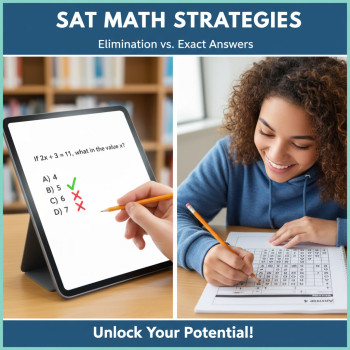Why the Digital SAT Left Paired Passages Behind — And Why That’s OK
If you’ve been studying for the SAT for a few years, you probably have a mental image of paired passages: two short texts, often on related topics, with a tangle of comparative questions that asked you to weigh evidence, contrast viewpoints, or find lines that both passages supported. They were a rite of passage for SAT readers.
Fast-forward to the Digital SAT, and you might notice something different: the paired-passage format has largely disappeared. That change has left many students wondering: did the test-makers make reading easier, or are they testing something else entirely? This article walks you through the reasons behind the change, what the Digital SAT now emphasizes, and how to adapt your study plan — including practical ways Sparkl’s personalized tutoring and tailored study plans can help make your transition smoother.
The big picture: Why the SAT redesigned reading passages for the digital age
Tests don’t change in a vacuum. The shift to a digital platform gave the College Board an opportunity to rethink how reading skills are measured. Moving from paper to a secure, adaptive, and shorter digital experience opened up new approaches to item design, time management, and accessibility. The result was not a simplification of reading skill assessment but a rebalancing — prioritizing depth of analysis, evidence use, and real-world reading skills rather than rote comparison tasks.
Digital delivery = different constraints, different opportunities
- Screen reading behaves differently than paper reading: passages and questions must be optimized for on-screen clarity and cognitive flow.
- Shorter test sections and a faster overall pace required designers to be more selective about which item types produce the most reliable measurement.
- Digital scoring and enhanced security allowed the test to focus on higher-quality items that measure critical reading and evidence use more directly.
What paired passages used to test — and how the Digital SAT covers those skills now
Paired passages were mainly a tool to assess two things at once: comparison and evidence-based reasoning. Students needed to synthesize information across texts and determine how evidence in one passage affected claims in another. That’s still important in college and life — but the Digital SAT measures those exact competencies differently.
Core skills remain central
Even without classic paired passages, the Digital SAT continues to test:
- Evidence identification: finding which lines or phrases support a claim.
- Inference: drawing reasonable conclusions that aren’t explicitly stated.
- Author’s purpose, tone, and perspective: understanding why a passage is written the way it is.
- Synthesis across ideas: connecting related concepts that may appear within a single passage or across multiple items.
How the format shifted
Instead of presenting two separate full passages for direct comparison, the Digital SAT often uses single passages with denser evidence-based questions, or a compact set of related items that probe the same analytical skills more efficiently. This approach can feel different at first — less about toggling between texts and more about plumbing the depth of a single passage or a tight cluster of related questions.
Reasons behind removing paired passages: design, fairness, and measurement
There are several reasons educational designers moved away from canonical paired passages on the Digital SAT. Understanding them helps you prepare more strategically.
1. Measurement efficiency
High-quality testing aims to measure a student’s ability accurately with the fewest, most informative questions. Paired passages required extra space and time to present two texts. Designers discovered they could measure the same analytical skills with fewer words and better-targeted questions, leading to a shorter, more focused test.
2. Screen readability and user experience
Reading two side-by-side texts or flipping between them on a small screen introduces usability and cognitive load issues. Simplifying to single, concentrated passages reduces scrolling, minimizes split attention, and improves accessibility for students using different devices or accommodations.
3. Fairness and accessibility
Paired passages sometimes put students with slower visual processing or reading-on-screen challenges at a disadvantage. The digital format aims to level the playing field: clearer layout, consistent navigation, and fewer moves between texts so the test measures comprehension, not interface-handling skills.
4. Emphasis on evidence and reasoning
Instead of asking whether passage A or passage B says X, the Digital SAT often asks which part of the passage best supports a claim, or how an author would respond to an idea. Those items get to the heart of college-ready reading: using textual evidence and reasoning clearly and decisively.
What this means for your study plan (concrete changes to make)
Short answer: focus less on the mechanics of juggling two texts and more on precision, evidence, and speed with denser passages. Here’s a practical checklist you can use during practice sessions.
| Old Paired-Passage Skills | Digital SAT Focus | Study Action |
|---|---|---|
| Comparing claims across two texts | Synthesizing evidence within a single, denser passage | Practice identifying sentence-level evidence and mapping claims to lines. |
| Alternate viewpoints between passages | Author’s stance and implied response within one text | Annotate passages for tone and intended audience; summarize author’s main point in one sentence. |
| Toggling between passages to answer cross-text questions | Answer clusters of related questions that probe depth on a theme | Do timed drills answering 3–5 question clusters from a single passage. |
| Looking for parallels across long texts | Precise evidence selection and inference from compact text | Practice line-referenced questions—circle the exact phrase that supports your answer. |
Sample practice routine (60 minutes)
- 10 minutes — Quick warm-up: read a contemporary editorial and write a one-sentence summary of the author’s claim.
- 30 minutes — Timed reading of a single passage with a cluster of 4–6 evidence-based questions; annotate as you go.
- 10 minutes — Review mistakes: identify the exact line that would have supported the correct answer.
- 10 minutes — Reflection: jot down what type of reasoning the question used (inference, main idea, function, tone).
Strategies that reliably work on the Digital SAT reading tasks
Many classic SAT strategies still apply, but they need slight adjustments for the digital format.
1. Annotate with purpose
Instead of underlining everything, use a few consistent shorthand marks: main claim, shifts in stance (But/However), and evidence lines (E). This mini-legend speeds recognition when you scroll back to answer evidence-based items.
2. Read for structure, not just facts
Look for the passage’s skeletal structure: introduction of an idea, support or evidence, a counterargument, and the conclusion. Many Digital SAT questions hinge on understanding how ideas are organized, so a quick structural map gives disproportionate payoff.
3. Answer with the passage, not your knowledge
On evidence questions, anchor responses to specific lines. If a question asks which choice is best supported by the passage, point to the actual sentence or phrase in your head before locking in your answer.
4. Practice micro-clusters
The Digital SAT often groups questions around a short text. Practice answering clusters of items that all relate to the same sentences. This builds the mental habit of moving from claim to justification quickly.
5. Time management and stamina
The Digital SAT is shorter but brisk. Use timed sections in your practice and simulate the digital interface when you can — the pacing you develop under realistic conditions is the pacing you’ll rely on on test day.
How Sparkl’s personalized tutoring can help (subtle, practical benefits)
Changes to test format are easier to handle with targeted help. Sparkl’s personalized tutoring offers focused advantages that fit naturally into the shift from paired passages to denser single-passage clusters:
- 1-on-1 guidance to diagnose whether your errors are comprehension, timing, or inference-based.
- Tailored study plans that shift practice from comparison drills to evidence-clustering exercises.
- Expert tutors who model annotation and thought processes out loud, so you internalize strategies faster.
- AI-driven insights to highlight question types where you lose points, helping you allocate practice time efficiently.
Think of Sparkl as the coach who helps you adapt your instincts — not to a textbook version of the SAT, but to the test you’ll actually see on the screen.
Examples and mini-walkthroughs — seeing the difference up close
Here are two simplified examples that show how the nature of questions has shifted. Each mini-exercise focuses on evidence and precision.
Example 1 — Main idea & evidence (single passage)
Passage summary: a short historical piece asserts that a community’s shared festivals were more resilient than official institutions during times of crisis.
- Question: Which sentence best supports the author’s claim that festivals were resilient?
- How to approach: find the sentence that explicitly ties festivals to community survival, not the sentence that merely mentions festivals in passing.
- Practice note: circle the specific clause that demonstrates resilience — that’s the evidence you would cite.
Example 2 — Function and tone (compact cluster)
Passage summary: a scientist critiquing a popular environmental policy uses a blend of technical data and wry sarcasm.
- Question cluster: One item asks about the function of paragraph 3 (to present a counterpoint), another asks how the author’s tone shifts (from measured to sarcastic), and a third asks which line best indicates skepticism.
- How to approach: map the passage’s move from claim to counterclaim, underline the line that expresses skepticism, then match your tone word to the author’s phrasing rather than your outside impression.
Practice resources and how to use them effectively
Good practice is focused practice. Here are principles, not a shopping list, to help you craft efficient sessions:
- Quality over quantity: 30 minutes of concentrated, mistake-focused practice is better than two hours of unfocused reading.
- Simulate the digital environment: if possible, practice on a screen and practice navigation and timing.
- Analyze errors carefully: convert every mistake into a one-line remediation note — e.g., “missed inference questions where evidence is implied, not stated.”
- Mix untimed analysis with timed drills: untimed work builds strategy, timed work builds stamina.
How a tutor can accelerate your progress
A tutor can do three things faster than solo study: identify weak patterns, demonstrate strategy in real time, and keep your practice plan adaptive. Sparkl’s expert tutors, for instance, can craft custom drills that move you from making the same error repeatedly to mastering the skill in a few sessions, backed by AI-driven feedback to track progress.
Common student worries — and realistic responses
Change creates uncertainty. Below are frequent worries students voice about the removal of paired passages, and how to think about them.
“Does this make the test easier?”
Not necessarily. The skill set tested is the same or arguably more focused: evidence-based reasoning, precise inference, and rapid organization. If anything, the test rewards tighter, more disciplined reading.
“Will old practice tests help?”
Old paper tests are still useful for core skills, but they’re less accurate models of pacing and interface. Use official Digital SAT practice materials where possible; supplement older materials with targeted drills that mimic the Digital SAT’s question clusters.
“How do I stop losing points on evidence questions?”
Make identifying the exact line your go-to habit. On any evidence question, force yourself to point to a line before answering. If you can’t, you probably don’t have the support the question asks for.
Checklist: 8 practical steps to master Digital SAT reading now
- Train with digital practice material to get comfortable with screen navigation and annotation.
- Learn a three-mark annotation system (claim, shift, evidence) and use it consistently.
- Do cluster drills: answer 3–5 related questions from one passage in one sitting.
- Practice line-selection: always identify the exact sentence or phrase that supports your answer.
- Time-box your review: after each practice set, spend 10 minutes analyzing mistakes, not just redoing questions.
- Alternate untimed deep-reading sessions with timed sprints to build both strategy and speed.
- Work with a tutor for targeted remediation — for example, Sparkl’s 1-on-1 sessions to fix a recurring error.
- Keep a short mistake log and revisit it weekly to ensure errors don’t recur.
Final thoughts: what the change really asks of you
The disappearance of paired passages on the Digital SAT isn’t a trick — it’s an invitation. The test now asks you to be sharper, more efficient, and more evidence-driven. It rewards readers who can zero in on the text, map the argument’s structure, and point to the exact words that matter.
If you focus your preparation on precision — practicing evidence selection, annotating for structure, and timing your work under realistic digital conditions — you’ll find the new format less mysterious and more predictable. And if you want to accelerate that progress, personalized tutoring (with tailored plans, expert tutors, and helpful AI-driven insights) can make your practice time far more effective.
Change can feel unnerving, but it’s also a chance to practice the exact skills colleges want: clarity, reasoning, and the ability to support your claims with evidence. Put in smart, focused practice, lean on personalized feedback when you need it, and you’ll not only survive the Digital SAT’s new format — you’ll master it.
Quick reminder
Start small, be consistent, and track one or two targeted weaknesses each week. Over time, the changes you make in your prep will compound into reading habits you’ll use in college and beyond.













No Comments
Leave a comment Cancel